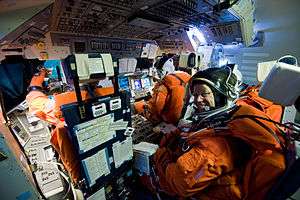Shuttle Mission Simulator

The Shuttle Mission Simulator (SMS) consisted of two simulators in Building 5 and one simulator in Building 35 of Johnson Space Center. The fixed-base simulators included high-fidelity mockups of the flight deck of a Space Shuttle, as well as a low-fidelity mockup of the middeck. The facility in Building 5 was known as the Fixed Base Simulator, while the facility in Building 35 was known as the GNS (an acronym for the original name, Guidance and Navigation Simulator[1]). The motion-base simulator consisted of the forward part of the flight deck of the Space Shuttle. It utilized a six-axis hexapod motion system with an additional extended pitch axis to provide motion cuing for all phases of flight.
The motion base simulator provided crews with computer generated visual scenes out of the forward windows only, while the fixed-base simulators supplied forward, aft, and overhead window views. Simulation software modeled all Space Shuttle systems including many pre-programmed malfunctions, response to cockpit controls, and interactions between systems. Before a flight, astronauts logged many hours in these simulators. Instructor stations in the complex allowed simulator instructors to monitor and control student progress in the simulations, including the insertion of malfunctions. A central simulation control office monitored the health of the facility, scheduled its use, and responded to maintenance requests.
Simulations (or "sims") which took place without interfacing to the Mission Control Center were called standalone simulations. Any of the simulators could be interfaced to the Mission Control Center to exercise an integrated simulation. The fixed-base simulators could be interfaced to the Space Station Training Facility to exercise a combined simulation. A full mission rehearsal simulation, involving both the Shuttle and Station simulators, and both Mission Control Centers, was called a dual integrated simulation. Interfacing with payload control facilities at Marshall Space Flight Center or Goddard Space Flight Center, with the control centers of Space Station Program international partners, and/or with the Neutral Buoyancy Laboratory was also possible as a joint integrated simulation. A dedicated console area in the Mission Control Center, the Simulation Control Area (or SCA), controlled simulation conduct while integrated.
As the Space Shuttle Program ended in July 2011, all the simulators in the SMS complex were mothballed and prepared for removal and transport as excess NASA inventory throughout 2012. The Fixed Base simulator will be an attraction at the Adler Planetarium in Chicago , the Motion Base simulator will be in the Aerospace Engineering department at Texas A&M University , and the GNS will be an attraction at the Wings of Dreams Aviation Museum at the Keystone Heights Airport in Starke, Florida, outside Gainesville .
References
- ↑ The GNS originally started as a simulator for just guidance and navigation, but was later upgraded to a full fixed-base simulator. The 1986 Rogers Commission Report records the following testimony on page 2510 as an early reference to the name: "Some other things that we needed and we are stepping out on this now is a guidance and navigation trainer. Right now if we want to teach a pilot, a commander flight techniques or teach him how to do the nav, we have to tie up the whole base to do that, and we shouldn't do that. We should have a part-task trainer. And we've been trying to get one of those for a long time. It looks like right now that we may very well be able to do that. We have got the thing rolling." (italics added for emphasis)
See also
| Wikimedia Commons has media related to Space Shuttle simulators. |